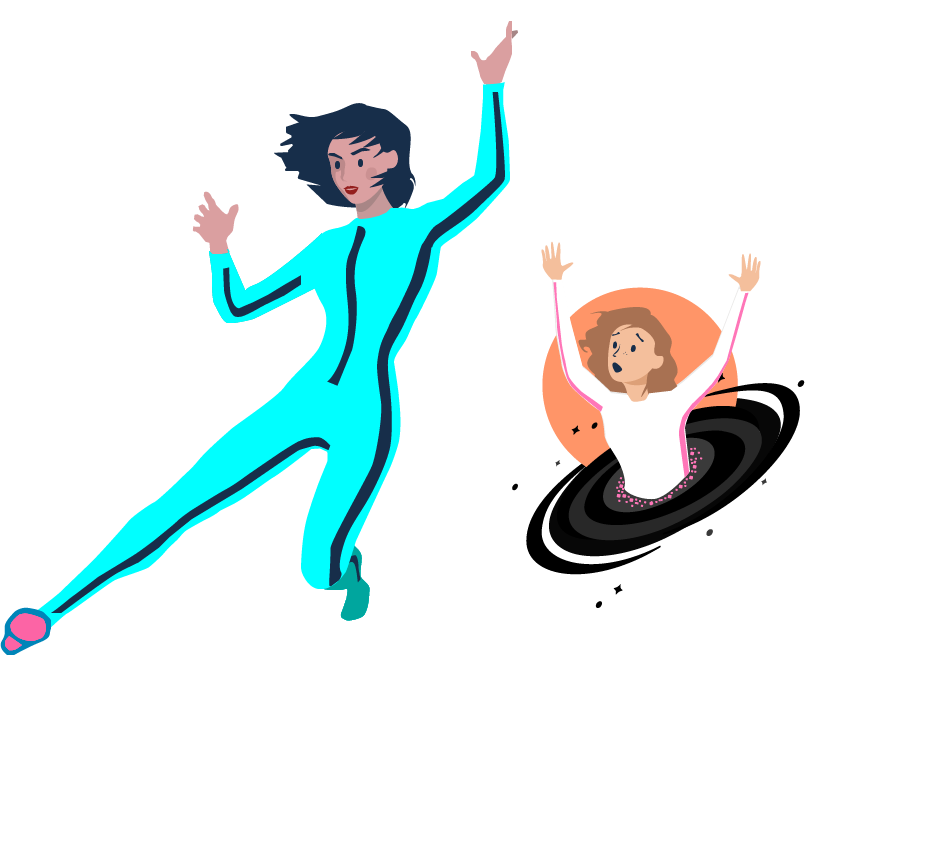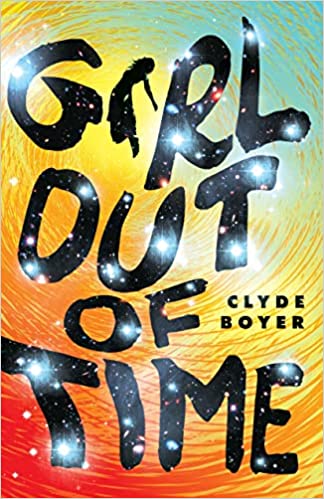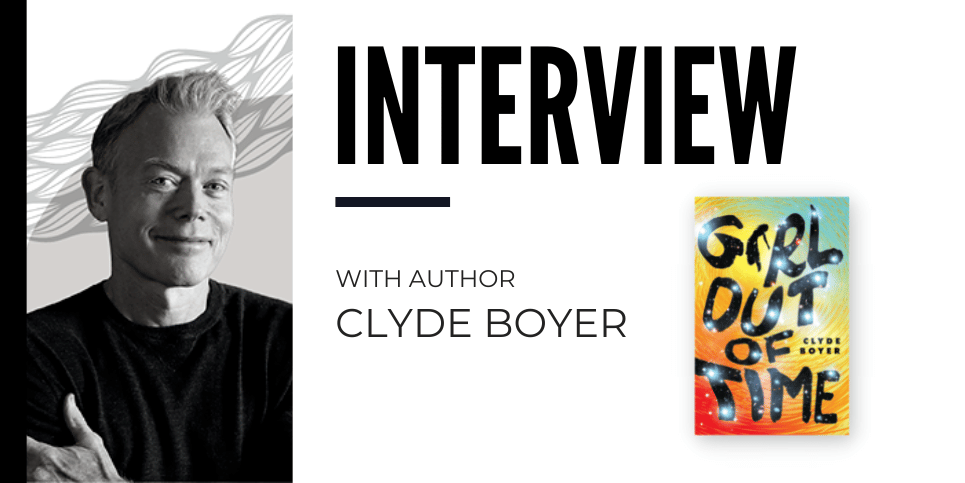The Children’s Book Review Interview in partnership with Clyde Boyer, author of Girl Out of Time.
Cofounder of Trinity Education Group and board member of the nonprofit Ops Health, Clyde Boyer is a social entrepreneur and former farm kid who has spent his life working with underserved youth and migrant populations and building learning hubs in Africa and Latin America. He is also a frequent public speaker and an advisory board member of SXSW EDU. A practicing Biomimic, he believes nature is the best teacher in solving many of our world’s issues. Girl Out of Time is a passion project aimed at providing hope to today’s youth. He lives in Ellicott City, Maryland.
In this chat about Girl Out of Time, Clyde talks about the inspiration for the story, space travel, aliens, the balance between science and imagination, and so much more!
Can you tell us a little bit about the inspiration for Girl Out of Time? What led you to want to tell a story about time travel and environmentalism?
Clyde Boyer: Like many things in my life, this was a happy accident. I wrote Girl Out of Time because it was something I wanted to read. The thing is, there aren’t too many sci-fi farming fairy tales out there. Trust me; I’ve looked. Secondly, I’ve worked with kids and teachers from around the world for most of my adult life. What I’ve found is that optimism for the future is in short supply or at best, not evenly distributed. How do we envision, or co-design, a future where we can all thrive? Well, first, we have to believe that a positive future is possible.
So, that’s how Girl Out of Time started, as a design experiment. Envision a potential future that is desirable, and then work backward to identify the changes that we need to make to get us there. The exercise took on a life of its own as I began weaving together the themes I love most in life — regenerative farming, nature, science, biomimicry, making, found family, and community — and in the process, I was introduced to characters I wanted to spend more time getting to know. Girl Out of Time became a time travel story. But at its heart, it’s a story about our environment and everyday people making a difference.
And, of course, the story had to have aliens. Really cool aliens. And funny friends, wormholes, alien landscapes, and awesome technology that is actually possible like anti-gravity, quantum computing, AI, and cloaking devices. And, while we’re at it…I’ve always wanted to be able to fly. That’s a big part of the story, too. Flying. Lots of flying.
One of the novel’s standout features is how you bring the Indiana landscape to life through sights, sounds, smells, and textures. Is this a landscape that is special to you?
It is, but in a way that every ecosystem is special to me. I grew up on a farm in the Blue Mountains ecoregion of Idaho. I’ve lived in the coastal desert of San Diego and in the densely wooded areas of Maryland. Each has its own distinct beauty. In biomimicry, we are trained to carry a nature journal wherever we go and to just sit and observe our surroundings — quietly and with no agenda.
At first, you just see nature as one big thing, then slowly, as your field of perception begins to relax you start to see patterns, movement, varying shades of color, and life dancing all around you. It’s kind of magical. It’s also something I tried to capture in Girl Out of Time. Like the great Hall of Fame baseball player Yogi Berra once said, “you can observe a lot by just watching.”
I’m really glad you tapped into the sensory aspects of Girl Out of Time. If you read the latest research, kids today are in a tough place. Mental health is on the decline and anxiety is on the rise. I think a big source of that decline is due to our disconnect from nature. So much of our life is mediated and focused inwards. Getting out into nature helps us get out of our own heads and see that we aren’t the center of the universe but part of something far greater. It helps us focus, improves our immune systems, and reduces stress.
My hope is that Girl Out of Time helps inspire kids and their parents to go outside, take in a deep breath, and just reconnect. Oh, and take a journal with you.

Anna is a firm believer in science, but she still knows how to dream, imagine, and enjoy flights of fancy. Do you think the balance between science and imagination is an important theme in the book and for life? Why or why not?
Science and imagination aren’t competing enterprises but part of the same process. In fact, all of the most important scientific advances started as inspired guesses. Acts of imagination. Every time we take a step up the ladder of scientific discovery, imagination greets us with beautiful questions and thought experiments. This is something I wish our schools focused a little more effort on. Knowledge alone isn’t sufficient. Nor is imagination. But, when you feed the imagination with knowledge and ideas, it’s like adding fuel to a fire.
Did you have to do a lot of research to write the book? What sorts of things were most fun to research and learn about?
A lot of my research was based on a set of skills called Futures Thinking. If you want to imagine the future of something, like the future of farming, look for signals and drivers today and imagine what farming will be like 10, 50, or 100 years from now. The goal is not to predict the future but to open a whole range of possibilities to help us create the future we want. It’s a really empowering skill I hope to be able to introduce to more kids.
Futures thinking allowed me to explore so many elements of Girl Out of Time, like the future of AI, space exploration, food, and even dating and family. Anti-gravity boots, which are featured so prominently in the book, were the hardest thing to research. Hypothetical concepts like negative mass or exotic matter that could create repulsive gravitational fields needed for anti-gravity boots have not been detected. Not yet. But, hey, that’s what the future is for, right?
Do you believe in space travel and aliens?
Absolutely! It’s hard not to. One of my favorite sections in Girl Out of Time is where Anna meets Mara for the first time and grills her with questions about the future. Of course, Anna asks if we’ve encountered aliens. It’d be one of the first things I’d ask. Mara’s response captures the most likely scenario for me and the most hopeful. There are hundreds of billions of galaxies in the known universe, perhaps much more based on recent findings from the Webb telescope. Trillions of stars. In the Milky Way alone, there are untold habitable planets.

One of the things I’ve learned in my biomimicry studies is that life finds a way even in the harshest of environments. The conditions for life are everywhere in the universe. So, based on what we know, the universe is likely teeming with life. But I’m also really curious about the nature of alien life like the Shadow creature in Girl Out of Time. If you look at our planet alone, there is such an abundance of varied lifeforms that provide us insight into just how different alien life may be. Take the octopus for example. Each of its tentacles has its own mini-brain that works independently, along with a larger central brain. Collective intelligence in one creature. An alien intelligence. That’s amazing.

What would you say is the most important discussion you would like Girl Out of Time to spark among readers?
I’d love it if Girl Out of Time provided a safe space for parents, teachers, and kids to discuss climate change. That’s the great thing about fiction. It can introduce kids to complex topics like climate change in a way that is more compelling than through a purely scientific lens. It helps kids connect the dots between facts, or their actions and changes in the environment, or even between their own situation and those of characters in faraway places.
But I think we need to move beyond the current narrative on climate impacts and fear to climate engagement and agency. Hopefully, books like Girl Out of Time can serve as a roadmap for possible climate solutions.
Kids first need to be able to envision a better future and then see how they can play a role. What jobs will help in this transition? What innovations will be required? The great thing is — climate change is intersectional. By addressing climate change, we are going to be addressing a slew of other issues like social justice and equity. If we do this right, we will be living in a radically better world. But this better world isn’t going to happen on its own. It’s going to take work and it’s going to take all of us engaged in one way or another.
One other discussion topic I’d love the Girl Out of Time to inspire is our need to reconnect with nature. How do we reengage kids and parents with the outside world? The problems we face like climate change or a broken food system take place in the physical world, but we’ve lost sight of how to solve big problems in the physical world.
We love that Anna and her family are “makers.” Are you a maker too? What is your favorite thing to make?
Growing up on a farm, we didn’t call people who built things “makers.” We called them farmers. When you’re resource-constrained like you are on a farm, everyone has to make do with whatever is laying around. It’s amazing how many things can be fixed with baling wire and a swift hard kick.
One of the reasons I love the maker movement is that it empowers kids to build their world. Too many things in our lives are a black box, like the phones we use. But, once you build something on your own, you start to see how things work. And, when you understand how things work on a basic level, you’re only limited by your imagination and the raw materials around you.
I loved building a 3D printer because I built something that allowed me to build more things. What I love now is citizen science and anything that uses sensors. It puts the average person right in the mix of real science and helps them make sense of the world around them.
You mentioned Rip Van Winkle in the press release—are there any other favorite children’s stories that have helped inspire the book?
Oh man, grab some coffee, pull up a chair, and let’s spend the next two days reviewing all the stories that helped inspire the book. Movies are a big source of inspiration, especially the films of Hayao Miyazaki, like My Neighbor Totoro and Spirited Away. Brilliant, beautiful movies that are wildly imaginative but deeply connected to nature.
Wizard of Oz is also another inspiration, both the movie and the book. The tornado scene absolutely terrified me as a kid and inspired a pivotal section of the Girl Out of Time. A Wrinkle in Time had a profound impact on me when I was young. One recent book I thoroughly enjoyed is The Loneliest Girl in the Universe by Lauren James. It’s really unpredictable, which I love, and the main character is someone you root for.
What will your next writing project be? Will it be similar to Girl in Time?
I just started on the sequel to Girl Out of Time, and I’m having so much fun exploring the possibilities of this universe. It’ll bring back all the characters from the first book but also introduce you to kids from around the world who are on the front lines of climate change. The stakes will be bigger, the action more intense, and the science of interdimensional travel even loopier.
I hinted at the end of the first book of the direction of future books. Now, I get a chance to build those ideas out; a school dedicated to making a better future, really cool transition technology, new friendships formed, and the return of a fan favorite…no spoiler alerts.
What resources would you recommend to readers inspired by this book who want to get involved in community activism and environmental work?
The problem of climate change can feel overwhelming. The best thing to do is arm yourself with information, get together with people who share a desire to make a change, and get out there. The following includes some of my go-to resources.
Ask Nature (https://asknature.org) is such a fantastic resource and totally addictive, but not in a bad way like TikTok. Just type in How Does Nature “conserve water”, “protect from harm”, or “transform chemical energy” and you get thousands of examples of how nature has already solved that problem. If anyone wants to inspire the next generation of problem solvers, life scientists, biologists, innovators, and entrepreneurs, the Ask Nature website is one of the best places to start.
Project Drawdown (https://drawdown.org) provides a clear roadmap to getting to a more equitable and healthy future. We have the solutions to address climate change today; they just haven’t been distributed equally. Project Drawdown lists and organizes inspiring initiatives and provides tangible ways we can all get involved now. Also, for the young person who wants to make an impact, Project Drawdown can really open up their eyes to the far-reaching world of jobs and opportunities available out there.
I’m also working with a great group of educators to create a series of educational resources that will be available on the Girl Out of Time website (https://girloutoftime.com). Sign up for the newsletter and I’ll make sure to keep you informed of updates.
Some other great resources include:
United Nations Youth in Action – https://www.un.org/en/climatechange/youth-in-action
United States Environmental Protection Agency – https://www.epa.gov/climate-change/climate-change-resources-educators-and-students
Climate Kids from NASA – https://climatekids.nasa.gov
Savory Institute on Regenerative Farming (yes, this served as inspiration for Uncle Jack) – https://savory.global
About the Book

Girl Out of Time
Written by Clyde Boyer
Ages 8+ | 364 Pages
Publisher: Girl Friday Books | ISBN-13: 9781954854222
Publisher’s Book Summary: A young girl befriends a time traveler on the run. Now, to save the world, she must learn to fly, track down aliens, and traverse space and time.
After thirteen-year-old Anna Armstrong loses her parents in an accident, she is sent to live on her Uncle Jack’s farm. She is despondent, but on her first night there, she is awoken by strange lights originating from a nearby lake. She sets out to investigate—and the skies suddenly erupt in a thunderous explosion.
That’s when Anna sees a mysterious woman floating across the lake.
She discovers Mara—the woman on the lake—is a time traveler on the run from frightening bone-white alien creatures. She also learns that time travel has consequences. Mara’s time-hopping escape has broken the universe, opening wormholes throughout the valley, each leading to another world.
Now, Mara needs Anna’s help—together, they must use science to track down the aliens and close the portals before anything escapes. But can they figure out how before Mara’s very existence is erased forever?
Girl Out of Time is a thrilling adventure of two unlikely friends who team up to take on a world of aliens, wormholes, and time travel—to save themselves and, possibly, the entire planet.
Girl Out of Time is a thought-provoking, intensely absorbing flight of fancy, perfect for every reader who dreams of flying further.
The Children’s Book Review
Buy the Book
This interview—Clyde Boyer Discusses Girl Out of Time—was conducted between Clyde Boyer and Dr. Jen Harrison. For similar books and articles, follow along with our content tagged with Aliens, Environmental, Friendship, and Space Travel.

